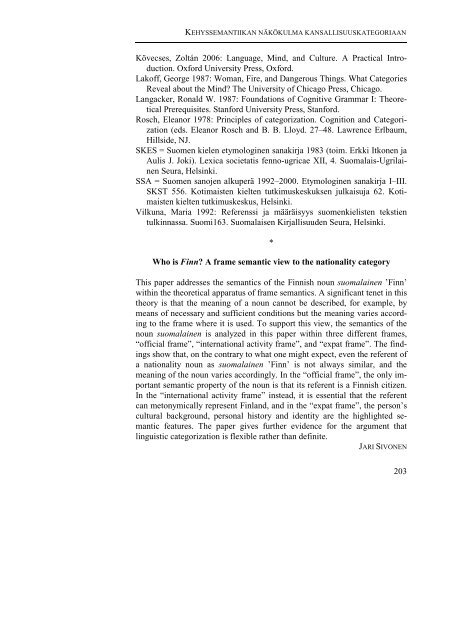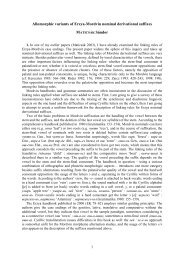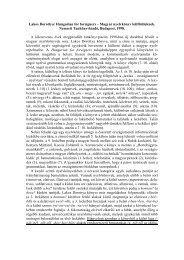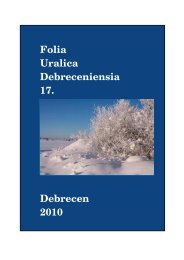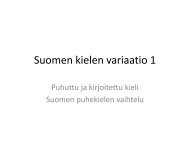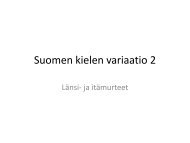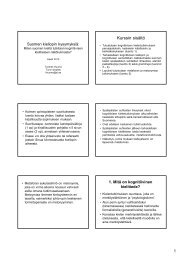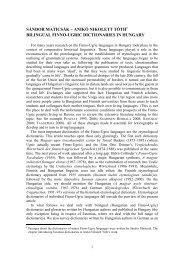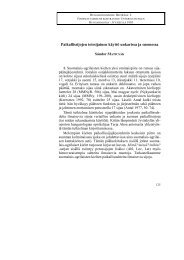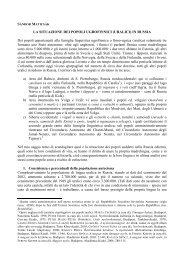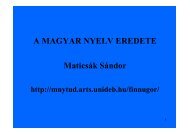folia uralica debreceniensia 19. - Finnugor Nyelvtudományi Tanszék
folia uralica debreceniensia 19. - Finnugor Nyelvtudományi Tanszék
folia uralica debreceniensia 19. - Finnugor Nyelvtudományi Tanszék
You also want an ePaper? Increase the reach of your titles
YUMPU automatically turns print PDFs into web optimized ePapers that Google loves.
KEHYSSEMANTIIKAN NÄKÖKULMA KANSALLISUUSKATEGORIAAN<br />
Kövecses, Zoltán 2006: Language, Mind, and Culture. A Practical Introduction.<br />
Oxford University Press, Oxford.<br />
Lakoff, George 1987: Woman, Fire, and Dangerous Things. What Categories<br />
Reveal about the Mind? The University of Chicago Press, Chicago.<br />
Langacker, Ronald W. 1987: Foundations of Cognitive Grammar I: Theoretical<br />
Prerequisites. Stanford University Press, Stanford.<br />
Rosch, Eleanor 1978: Principles of categorization. Cognition and Categorization<br />
(eds. Eleanor Rosch and B. B. Lloyd. 27–48. Lawrence Erlbaum,<br />
Hillside, NJ.<br />
SKES = Suomen kielen etymologinen sanakirja 1983 (toim. Erkki Itkonen ja<br />
Aulis J. Joki). Lexica societatis fenno-ugricae XII, 4. Suomalais-Ugrilainen<br />
Seura, Helsinki.<br />
SSA = Suomen sanojen alkuperä 1992–2000. Etymologinen sanakirja I–III.<br />
SKST 556. Kotimaisten kielten tutkimuskeskuksen julkaisuja 62. Kotimaisten<br />
kielten tutkimuskeskus, Helsinki.<br />
Vilkuna, Maria 1992: Referenssi ja määräisyys suomenkielisten tekstien<br />
tulkinnassa. Suomi163. Suomalaisen Kirjallisuuden Seura, Helsinki.<br />
*<br />
Who is Finn? A frame semantic view to the nationality category<br />
This paper addresses the semantics of the Finnish noun suomalainen ’Finn’<br />
within the theoretical apparatus of frame semantics. A significant tenet in this<br />
theory is that the meaning of a noun cannot be described, for example, by<br />
means of necessary and sufficient conditions but the meaning varies according<br />
to the frame where it is used. To support this view, the semantics of the<br />
noun suomalainen is analyzed in this paper within three different frames,<br />
“official frame”, “international activity frame”, and “expat frame”. The findings<br />
show that, on the contrary to what one might expect, even the referent of<br />
a nationality noun as suomalainen ’Finn’ is not always similar, and the<br />
meaning of the noun varies accordingly. In the “official frame”, the only important<br />
semantic property of the noun is that its referent is a Finnish citizen.<br />
In the “international activity frame” instead, it is essential that the referent<br />
can metonymically represent Finland, and in the “expat frame”, the person’s<br />
cultural background, personal history and identity are the highlighted semantic<br />
features. The paper gives further evidence for the argument that<br />
linguistic categorization is flexible rather than definite.<br />
JARI SIVONEN<br />
203


